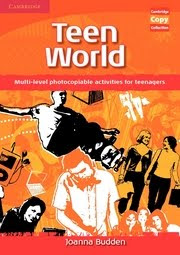Teaching teenagers-an interesting approach

Imagine not being able to remember, or never having experienced the following: black and white televisions, Live Aid, Space Invaders, the Soviet Union, studying without the internet, phones that you dialed instead of pressed, cameras which you couldn’t see the photo you had just taken and computers without a mouse. Welcome to the world of the modern teenager. Teens are often the hardest age group for teachers to cope with. I’ve always liked teaching teens, even though my first experience with a high school also gave me my first grey hairs. A colleague and friend of mine, Joanna Budden, has just written her first resource book especially on the topic. She’s someone who has a lot of experience with teens and no grey hairs at all! I asked her for six things to bear in mind…
1. The Natural Information-Gap
One of the great things about teaching teenagers is that there’s little need for pre-fabricated ‘information gap’ activities as there’s normally a huge, natural information gap between the students and the teacher! They may well know all about the latest music, technology, fashion trends and gadgets and you may not! So, rather than ignoring this void between you, exploit it to your advantage to find out as much as you can about what it’s like being a teenager these days.
2. They’re still young.
Some students who are now in their late teens can be very sophisticated, and it’s sometimes easy for forget that they are still young. So, to put things in perspective and to remind you that they haven’t in fact been on this earth for all that long, remember that they were only aged between five and ten when the Twin Towers were hit. Or imagine Britney Spears being around for as long as you can remember (scary thought). Our teen students of today were aged between two and seven when Britney released her first single!
3. Parents can be your allies!
It’s sometimes easy to forget that our teenage students haven’t just arrived from another planet. When they rock into your classroom with their i-pod blaring, their trousers hanging dangerously low down, designer pants on show and their fringe covering half their face, it’s tempting to wonder if their space ship is parked outside. But no, more often than not your teenage students have parents who care about them greatly and are often investing a lot of money for their child to learn English. Therefore, if problems do occur with certain students in your class, don’t hesitate to get in contact with their parents. They can often shed light on issues that are concerning you and it’s usually useful to have the parents’ support with any challenging students.
4. Your students have lives outside your classroom.
Obviously all students have ‘real lives’ that go on outside your classroom whatever their age. However for adults it’s somehow easier for them to ‘park’ their real lives outside the door for an hour or two when they come into class. Teenagers often bring with them all their baggage from a tricky day at school, and this may affect their behaviour in your class. If they’ve just got a text message from an admirer or if they’ve failed an exam that day and have yet to tell their parents, it may be difficult for them to give your class 100% attention, or even 10%. Finding out about how your students’ week is going before you start the class is one way to give your students a chance to let you know why they may not be the model student on that particular day. Here’s a link to an activity called the Happy Graph which gives you the chance for your students to do this. It can really give you an insight into the emotional roller-coaster that is teenage life.
5. Knowing what your students are into helps.
This may sound very obvious, but I think it’s even more important with teens than with any other age group to know as much as you can about each and every student you teach. By knowing what they do in their free time, who’s into computer games, who loves Formula 1 and who is going on a foreign exchange you will be able to tap into your students’ passions and interests in your class. Also, the better you know your students, and they know each other, the better the dynamics of the classroom will be. The five minutes at the beginning when students are arriving is vital time to chat to your students and to let them chat to each other (in English if possible) to find out what’s going on in their lives. Make sure students feel comfortable asking you questions too, obviously it’s up to each teacher how much of their ‘real life’ they want to share with their students but generally a positive learning environment is created from an open classroom atmosphere where the teacher is genuinely interested in their students.
6. There are lots of ‘techie teens’ out there.
Technology is inevitably a big part of your teenage students’ lives. Your students probably spend a large part of their day plugged into their mp3 player, using Messenger, Facebook, sending text messages, playing games or downloading music. They have grown up surrounded with technology so let’s use this fact to our advantage. Creating a class blog or wiki, asking students to e-mail you their homework or asking them to help you out when the class computer or IWB goes wrong are all ways of using their technological knowledge to your benefit!
Joanna Budden is an author and teacher based just outside Barcelona. Joanna has written materials for coursebooks and has produced many lessons for the Essential UK site of the British Council (lesson plans on UK culture). She is the author of Teen World by Cambridge University Press (pictured above, click on the image to find out more about the book).
1. The Natural Information-Gap
One of the great things about teaching teenagers is that there’s little need for pre-fabricated ‘information gap’ activities as there’s normally a huge, natural information gap between the students and the teacher! They may well know all about the latest music, technology, fashion trends and gadgets and you may not! So, rather than ignoring this void between you, exploit it to your advantage to find out as much as you can about what it’s like being a teenager these days.
2. They’re still young.
Some students who are now in their late teens can be very sophisticated, and it’s sometimes easy for forget that they are still young. So, to put things in perspective and to remind you that they haven’t in fact been on this earth for all that long, remember that they were only aged between five and ten when the Twin Towers were hit. Or imagine Britney Spears being around for as long as you can remember (scary thought). Our teen students of today were aged between two and seven when Britney released her first single!
3. Parents can be your allies!
It’s sometimes easy to forget that our teenage students haven’t just arrived from another planet. When they rock into your classroom with their i-pod blaring, their trousers hanging dangerously low down, designer pants on show and their fringe covering half their face, it’s tempting to wonder if their space ship is parked outside. But no, more often than not your teenage students have parents who care about them greatly and are often investing a lot of money for their child to learn English. Therefore, if problems do occur with certain students in your class, don’t hesitate to get in contact with their parents. They can often shed light on issues that are concerning you and it’s usually useful to have the parents’ support with any challenging students.
4. Your students have lives outside your classroom.
Obviously all students have ‘real lives’ that go on outside your classroom whatever their age. However for adults it’s somehow easier for them to ‘park’ their real lives outside the door for an hour or two when they come into class. Teenagers often bring with them all their baggage from a tricky day at school, and this may affect their behaviour in your class. If they’ve just got a text message from an admirer or if they’ve failed an exam that day and have yet to tell their parents, it may be difficult for them to give your class 100% attention, or even 10%. Finding out about how your students’ week is going before you start the class is one way to give your students a chance to let you know why they may not be the model student on that particular day. Here’s a link to an activity called the Happy Graph which gives you the chance for your students to do this. It can really give you an insight into the emotional roller-coaster that is teenage life.
5. Knowing what your students are into helps.
This may sound very obvious, but I think it’s even more important with teens than with any other age group to know as much as you can about each and every student you teach. By knowing what they do in their free time, who’s into computer games, who loves Formula 1 and who is going on a foreign exchange you will be able to tap into your students’ passions and interests in your class. Also, the better you know your students, and they know each other, the better the dynamics of the classroom will be. The five minutes at the beginning when students are arriving is vital time to chat to your students and to let them chat to each other (in English if possible) to find out what’s going on in their lives. Make sure students feel comfortable asking you questions too, obviously it’s up to each teacher how much of their ‘real life’ they want to share with their students but generally a positive learning environment is created from an open classroom atmosphere where the teacher is genuinely interested in their students.
6. There are lots of ‘techie teens’ out there.
Technology is inevitably a big part of your teenage students’ lives. Your students probably spend a large part of their day plugged into their mp3 player, using Messenger, Facebook, sending text messages, playing games or downloading music. They have grown up surrounded with technology so let’s use this fact to our advantage. Creating a class blog or wiki, asking students to e-mail you their homework or asking them to help you out when the class computer or IWB goes wrong are all ways of using their technological knowledge to your benefit!
Joanna Budden is an author and teacher based just outside Barcelona. Joanna has written materials for coursebooks and has produced many lessons for the Essential UK site of the British Council (lesson plans on UK culture). She is the author of Teen World by Cambridge University Press (pictured above, click on the image to find out more about the book).
See the original here:

Comentarii
Trimiteți un comentariu